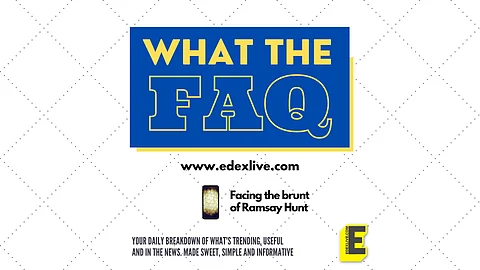

Through an Instagram video, Canadian pop singer Justin Bieber shared that he was diagnosed with Ramsay Hunt syndrome on Friday, June 10. He apologised to fans who were frustrated with him for cancelling his Justice World Tour, which was scheduled to begin on June 14. Bieber also spoke about how this disease is caused and hoped he would get well soon.
What the Baby singer shared in the about three-minute-long video has left people rummaging on the internet for more information on the disease. We come to the rescue of these concerned and curious minds. Here's all you need to know about the strange illness.
What is the Ramsay Hunt syndrome?
Ramsay Hunt syndrome is a disease caused by the varicella-zoster virus. It is the same virus that causes chickenpox and shingles. When this virus affects a nerve in the head, the Ramsay Hunt syndrome begins. In people affected by it, the virus is believed to infect the facial nerve near the inner ear. This leads to irritation and swelling of the nerve. A painful rash appears around the inner ear, face and even the mouth.
Does this syndrome have different types?
There are three kinds of Ramsay Hunt syndromes as detected in people. The first kind is known as zoster oticus which causes peripheral facial palsy. It is also called Ramsay Hunt cerebellar syndrome and is a rare form of cerebellar degeneration. The second type is known as herpes zoster oticus, affecting the ear and brain. Justin Bieber has been diagnosed with this Type 2 disease. And the third kind is a rarer condition that affects the ulnar nerve in the elbow and is known as artisan's palsy.
What's with the name?
The three types were diagnosed by the famous neurologist James Ramsay Hunt (1872-1937), who was a professor at the Columbia University School of Medicine. He described the discrete symptoms for each type and his research was a breakthrough in the early 20th century. His findings helped save the lives of people and find cures for this disease. Hence, the three types were named after him.
What are the symptoms?
To start with, people affected by this syndrome may experience severe pain in the ear and a painful rash on the eardrum, ear canal, earlobe, roof of the mouth and even on the tongue, on the side in which the affected nerve lies. It is common for people affected by Type 2 syndrome to experience hearing loss on one side. People may experience vertigo.
It is common for people with Types 1 and 2 syndromes to have weakness on one side of the face that causes difficulty in closing one eye, eating, making expressions, and making other facial movements. people affected by Type 1 syndrome may also experience confusion and dementia.
Complications also may occur in some cases when the infected nerve affects other nerves, and people may experience changes in taste, facial disfigurement, persistent pain, damage to the eye, leading to vision loss and nerves growing back in the wrong structures, causing abnormal reactions to a movement. In these cases, hospitalisation is required.
How is it detected?
Ramsay Hunt Syndrome is usually diagnosed by a professional by looking for signs of weakness in the face and a blister-like rash. Blood tests for varicella-zoster virus, Electromyography (EMG), lumbar puncture (in rare cases), MRI of the head, nerve conduction (to determine the amount of damage to the facial nerve), spinal tap (to test if other areas around the spinal cord have been affected) and skin tests for the varicella-zoster virus are some of the other tests which help in detecting the disease.
What are the treatments available?
There is no one medicine or course of treatment. While strong anti-inflammatory drugs called steroids, like prednisone, are usually given; anti-viral medicines, such as acyclovir or valacyclovir may also be prescribed. Sometimes strong painkillers are also needed if there is persistent pain, even with the steroids. If there is weakness in the face or difficulty in closing an eye, it is advised to wear an eye patch to prevent injury to the cornea and other damages to the eye. A special eye lubricant is also prescribed for use at night and artificial tears during the day to prevent the eye from drying out. In case of other symptoms or complications, different medicines or treatments are advised accordingly.
Why is early treatment important?
It is important to note that there is no prevention available for this disease. It is advised for a person suffering from rash or pain around the ear or face to immediately consult a doctor, as the chances of recovery are better if the treatment is started within three days after the symptoms begin. When treatment is started within this timeframe, most people make a full recovery. However, if it is delayed by more than three days, there is less chance of a complete recovery. It is known that children are more likely to have a complete recovery than adults.
How long does it take to recover?
There is no fixed recovery time. If the symptoms are not complicated and the treatment has started early, people may recover completely within a few weeks. But if the damage is severe, then complete recovery is not guaranteed even after several months.
This is the reason Justin Bieber shared that he did not know when he will recover completely, and do what he was "born to do".
